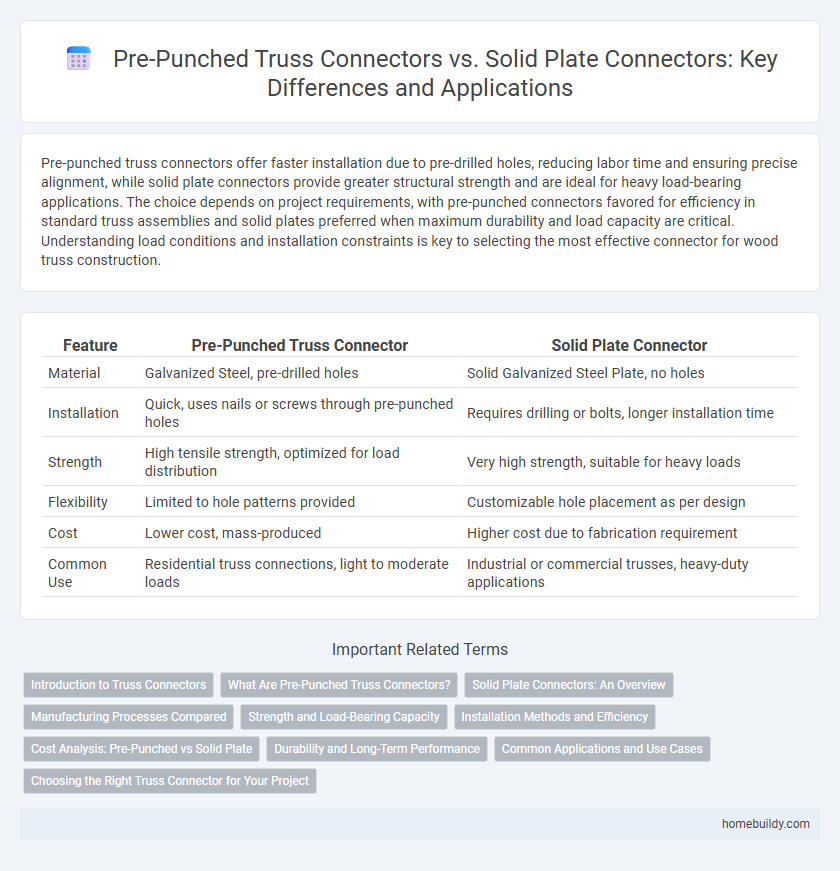Pre-punched truss connectors offer faster installation due to pre-drilled holes, reducing labor time and ensuring precise alignment, while solid plate connectors provide greater structural strength and are ideal for heavy load-bearing applications. The choice depends on project requirements, with pre-punched connectors favored for efficiency in standard truss assemblies and solid plates preferred when maximum durability and load capacity are critical. Understanding load conditions and installation constraints is key to selecting the most effective connector for wood truss construction.
Table of Comparison
| Feature | Pre-Punched Truss Connector | Solid Plate Connector |
|---|---|---|
| Material | Galvanized Steel, pre-drilled holes | Solid Galvanized Steel Plate, no holes |
| Installation | Quick, uses nails or screws through pre-punched holes | Requires drilling or bolts, longer installation time |
| Strength | High tensile strength, optimized for load distribution | Very high strength, suitable for heavy loads |
| Flexibility | Limited to hole patterns provided | Customizable hole placement as per design |
| Cost | Lower cost, mass-produced | Higher cost due to fabrication requirement |
| Common Use | Residential truss connections, light to moderate loads | Industrial or commercial trusses, heavy-duty applications |
Introduction to Truss Connectors
Pre-punched truss connectors feature factory-made holes that streamline installation by allowing easy nail or screw placement, reducing labor time and errors. Solid plate connectors, without pre-punched holes, require on-site drilling or nailing, offering flexibility but increasing installation complexity. Both types provide structural reinforcement for wood trusses, with selection dependent on project speed and customization needs.
What Are Pre-Punched Truss Connectors?
Pre-punched truss connectors are metal plates with pre-cut holes designed to facilitate easy and precise nail or screw placement during truss assembly, enhancing structural integrity and installation efficiency. Unlike solid plate connectors, which require manual drilling, pre-punched connectors reduce labor time and minimize errors in fastener alignment. These connectors are commonly used in roof and floor truss systems to ensure strong, reliable joints while streamlining the construction process.
Solid Plate Connectors: An Overview
Solid plate connectors offer superior structural integrity for truss assemblies by providing continuous metal surfaces, which enhance load distribution and resistance to shear forces. Made from high-strength galvanized steel, these connectors resist corrosion and ensure long-term durability in various environmental conditions. Their solid construction facilitates easier installation with fewer fastening points compared to pre-punched alternatives, resulting in a robust and reliable connection for heavy-duty truss applications.
Manufacturing Processes Compared
Pre-punched truss connectors undergo a stamping process that creates precise nail holes, streamlining installation and reducing labor time on-site. Solid plate connectors require secondary punching or drilling after fabrication, which adds complexity and increases manufacturing costs. The stamping method for pre-punched plates ensures consistent hole alignment and maintains structural integrity, making it a preferred choice in mass-produced truss systems.
Strength and Load-Bearing Capacity
Pre-punched truss connectors provide consistent hole placement that facilitates accurate fastener alignment, resulting in reliable load distribution but may have slightly reduced strength at the perforation points compared to solid plate connectors. Solid plate connectors offer superior load-bearing capacity and structural integrity due to their continuous, unperforated steel surface, which allows for maximum resistance to shear and tension forces. Engineers often prioritize solid plates in high-stress applications to ensure optimal strength, while pre-punched connectors are favored for ease of installation without significantly compromising load performance.
Installation Methods and Efficiency
Pre-punched truss connectors feature factory-produced holes that streamline installation by allowing quick alignment and fastening with nails or screws, significantly reducing labor time compared to solid plate connectors. Solid plate connectors require on-site drilling or marking, which prolongs installation and increases potential for misalignment. The precision and standardized hole placement in pre-punched connectors enhance efficiency and ensure consistent structural integrity.
Cost Analysis: Pre-Punched vs Solid Plate
Pre-punched truss connectors typically reduce labor costs by enabling faster installation and minimizing on-site modifications compared to solid plate connectors, which often require drilling or cutting. Material expenses for pre-punched connectors can be slightly higher due to manufacturing precision, but overall project costs tend to be lower when factoring in reduced labor time and errors. Solid plate connectors might offer cost benefits in smaller projects where customization is minimal, but pre-punched options provide greater cost efficiency in large-scale or repetitive truss assembly tasks.
Durability and Long-Term Performance
Pre-punched truss connectors exhibit enhanced durability due to precise manufacturing processes that ensure consistent hole placement, reducing stress concentrations and potential cracks. Solid plate connectors, while robust, can experience weakened integrity over time from stress around manually punched holes and exposure to environmental factors. Choosing pre-punched connectors improves long-term performance by maintaining structural stability and minimizing maintenance needs in wood framing applications.
Common Applications and Use Cases
Pre-punched truss connectors are widely used in residential roofing and light framing projects due to their ease of installation and compatibility with standard dimensional lumber. Solid plate connectors offer superior strength and durability, making them ideal for heavy-duty structural applications such as commercial buildings and large-span roof trusses. Both types ensure secure joints in wood trusses, but pre-punched plates suit quick assembly while solid plates are preferred for high-load and high-stress environments.
Choosing the Right Truss Connector for Your Project
Pre-punched truss connectors offer faster installation and improved alignment due to pre-drilled holes, reducing labor time and ensuring a precise fit. Solid plate connectors provide superior strength and durability for heavy-load applications or complex structural requirements, making them ideal for projects demanding maximum stability. Evaluating load demands, installation efficiency, and structural specifications helps determine the optimal truss connector for enhanced performance and safety.
pre-punched truss connector vs solid plate connector Infographic

 homebuildy.com
homebuildy.com